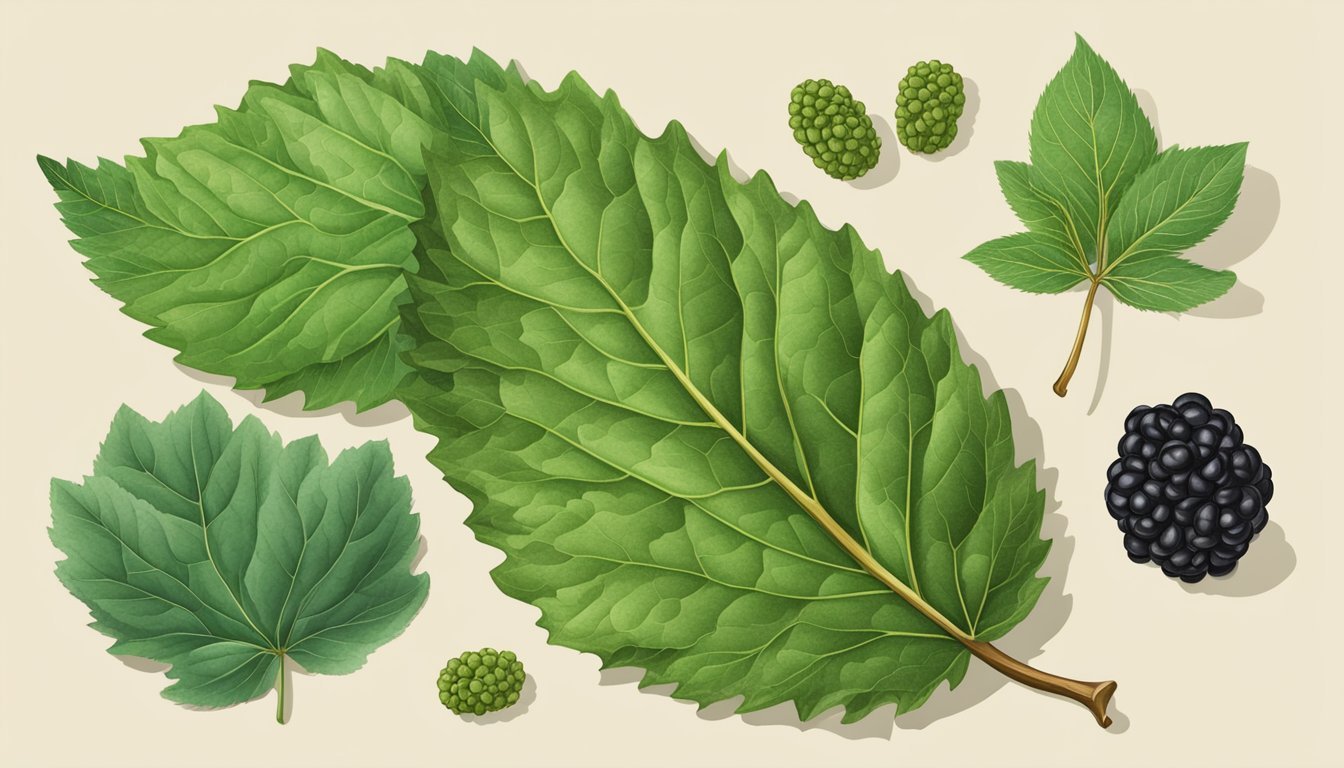Mulberry Leaves Substitutes
Best Alternatives for Health Benefits
For those looking to substitute mulberry leaves in their diet, there are several excellent alternatives that can provide similar health benefits. One popular substitute is Moringa leaves, known for their rich nutrient profile and antioxidant properties. These leaves can support heart health, regulate blood sugar levels, and reduce inflammation, making them a great match for the benefits offered by Morus leaves.
Another option is Nettle leaves, which are packed with vitamins and minerals. They offer potential benefits for skin health, inflammation, and blood pressure regulation. Nettle leaves can be easily used in teas, similar to how mulberry leaf tea is traditionally prepared.
Spinach leaves also make a versatile and accessible substitute. They provide a wealth of vitamins, including vitamin A, C, and K, alongside iron and calcium. Spinach is readily available and can be incorporated into a variety of dishes, from salads to smoothies, ensuring that your diet remains nutritious and balanced even without mulberry leaves.
Understanding Mulberry Leaves
Mulberry leaves are a significant component of traditional and medicinal uses, providing numerous health benefits and serving various culinary purposes. These leaves, coming from trees native to different parts of the world, boast diverse nutritional content and botanical characteristics.
Botanical Profile
The mulberry tree is a deciduous tree, widely cultivated for its leaves, especially in regions such as Asia, China, the United States, Europe, and Africa. Three primary species are commonly recognized: Morus alba (white mulberry), Morus nigra (black mulberry), and Morus rubra (red mulberry).
White mulberry (Morus alba) is extensively grown for silkworm cultivation. Black mulberry (Morus nigra) has been popular in Europe for centuries, while red mulberry (Morus rubra) is native to North America. These trees have lobed leaves, which can vary in shape, aiding in their identification.
Nutritional Content
Mulberry leaves are rich in various nutrients, making them beneficial as dietary supplements. They contain high levels of antioxidants, proteins, and essential vitamins like A, B1, B2, and C. Additionally, they provide significant amounts of minerals:
Iron
Zinc
Calcium
Potassium
Phosphorus
Magnesium
These nutrients help support overall health, offering a natural way to supplement a diet. For instance, antioxidants in mulberry leaves combat oxidative stress, while the diverse vitamin and mineral profile aids in essential bodily functions.
Health Benefits
Mulberry leaves provide numerous health benefits owing to their rich nutritional content. They support heart health by helping to manage cholesterol levels and improving vascular health. The leaves are also known for their role in blood sugar regulation, making them useful for people with diabetes or those looking to prevent type 2 diabetes.
Anti-inflammatory properties in the leaves aid in reducing inflammation, which can decrease the risk of chronic diseases like heart disease and cancer. Moreover, mulberry leaf tea and extracts are often used to enhance weight loss efforts by boosting metabolism.
Traditional and Medicinal Uses
Mulberry leaves have a long history in traditional medicine. In China and other parts of Asia, they are used to prepare herbal teas, tinctures, and medicinal elixirs. These traditional remedies leverage the leaves' health-promoting properties to treat ailments such as high blood pressure, digestive issues, and respiratory problems.
The use of mulberry leaves in medicinal contexts extends to mulberry leaf tea, believed to offer therapeutic benefits, particularly for maintaining cardiovascular health and managing diabetes. Additionally, mulberry leaf extract is a common ingredient in various health supplements aimed at providing these benefits in a concentrated form.
Culinary Applications
Mulberry leaves offer unique flavors and health benefits, making them a versatile ingredient in various culinary practices. Their use ranges from brewing aromatic teas to incorporating them in traditional dishes and dietary supplements.
Mulberry Tea Preparation
Mulberry leaf tea, a popular herbal tea, uses fresh or dried leaves. To make this tea, add green mulberry leaves to cold water and gradually bring it to a boil. After boiling for about 15-20 minutes, sweeten it with honey if desired. It can be enjoyed hot or chilled over ice. Rich in antioxidants, mulberry leaf tea is known for potential health benefits, such as supporting metabolic health and reducing inflammation.
Cooking with Mulberry Leaves
In culinary traditions, mulberry leaves are used as wrappers for foods, similar to grape leaves in dolma. When using mulberry leaves for cooking, blanch them to improve their pliability and texture. This step makes them easier to handle while preserving their nutrients. The leaves add a subtle flavor and can be stuffed with rice, meat, or vegetables. Additionally, mulberry leaves can be chopped and added to soups or stir-fries, providing both flavor and nutritional benefits.
Dietary Supplements
Mulberry leaves are processed into dietary supplements, including mulberry leaf extract and powder. These supplements are rich in vitamins, minerals, and beneficial plant compounds. They are often marketed for their potential to support blood sugar regulation and provide antioxidants. Available in capsule or powder form, mulberry leaf supplements are used to enhance nutritional intake. When incorporating these supplements into a diet, it is essential to follow dosage recommendations to avoid potential side effects.
Identifying Substitutes
Substituting mulberry leaves requires finding alternatives that match their culinary, nutritional, and medicinal virtues. Alternatives span across cooking uses, herbal teas, and dietary supplements rich in antioxidants, vitamins, and minerals.
Alternative Leaves in Cooking
In terms of cooking, spinach and kale are two viable substitutes. Both have a similar texture and can absorb flavors well when cooked. Spinach offers a mild flavor and is rich in iron and vitamin A, making it an excellent replacement.
Grape leaves are another option. They are often used in Mediterranean dishes and can mimic mulberry leaves in stuffed or wrapped dishes. Grape leaves also contain flavonoid antioxidants, which contribute to heart health and anti-inflammatory properties.
Herbal Tea Alternatives
For herbal teas, green tea and moringa tea are noteworthy substitutes. Green tea is widely known for its antioxidants and flavonoids that benefit cardiovascular health. It also has a well-established profile in blood sugar regulation, much like mulberry leaves.
Moringa tea is another strong contender. It is packed with vitamins such as vitamin C and minerals like calcium. It also boasts anti-inflammatory properties, making it a valuable alternative for those seeking health benefits similar to mulberry leaves.
Substitute Supplements
When it comes to supplements, quercetin and berberine are recommended. Quercetin is a flavonoid found in various fruits and vegetables that offers significant antioxidant and anti-inflammatory effects. It supports cardiovascular health and may help in blood sugar regulation.
Berberine is another supplement with properties similar to mulberry leaves. It works by enhancing insulin sensitivity and supports healthy blood sugar levels. Berberine also has anti-inflammatory and antioxidant benefits, making it a suitable dietary supplement.
By considering these alternatives, individuals can find practical and beneficial substitutes for mulberry leaves in their diet and health regimen.
Potential Risks and Side Effects
Mulberry leaves, while offering a range of health benefits, have potential risks and side effects that should be considered. Individuals taking medications or with certain health conditions should exercise caution.
Common Adverse Reactions
Most people tolerate mulberry leaves well. However, some may experience gastrointestinal issues like nausea, bloating, or diarrhea. These reactions usually occur when mulberry leaves are consumed in large quantities.
Allergic reactions are rare but possible. Symptoms may include skin irritation, itching, or rashes. Those with latex allergies should be particularly cautious due to the latex-like sap found in mulberry leaves.
Interactions and Contraindications
Mulberry leaves can lower blood sugar levels. This may interfere with diabetes medications, potentially causing hypoglycemia. Those on blood sugar-lowering drugs should monitor their levels closely when consuming mulberry products.
There might be potential interactions with medications for heart health and cholesterol regulation. Mulberry leaves may amplify the effects of these medications, necessitating dosage adjustments. Consulting a healthcare provider before adding mulberry leaves to a regimen is crucial.
Precautions for Specific Populations
Pregnant and breastfeeding women should approach mulberry leaves with caution due to insufficient safety data. It's best to avoid or limit consumption unless advised by a healthcare provider.
Individuals with chronic diseases like diabetes, heart disease, or kidney issues should discuss with their doctors before using mulberry leaves as part of their treatment plan. Children and the elderly, who may be more sensitive to supplements, should also use with caution, ensuring doses are suitable for their age and health status.
Conservation and Sustainability
Mulberry trees, essential for silkworm cultivation and traditional medicine, have substantial impacts on ecosystems where they grow. Sustainable practices are crucial to ensure environmental balance and promote long-term benefits.
Impact of Cultivation
The cultivation of mulberry trees involves large-scale planting. These deciduous trees can enhance soil quality and assist in reforestation projects. Their extensive root systems help prevent soil erosion and promote water conservation.
Mulberry tree leaves are a critical food source for silkworms, making them economically vital. However, unchecked expansion can lead to invasiveness, disrupting local ecosystems. Thoughtful planning and environmental assessments are necessary to mitigate negative impacts.
Moreover, their role in traditional medicine aligns with eco-friendly practices. Utilizing mulberry tree leaves sustainably ensures that their benefits continue without harming the environment.
Sustainable Harvesting Practices
Sustainable harvesting of mulberry tree leaves involves mindful practices. Selective pruning ensures the tree's health and maximizes leaf yield without causing damage. Effective nutrient management strategies enhance foliage quality, supporting both silkworms and medicinal uses.
Implementing crop rotation and organic farming techniques reduces reliance on chemical inputs. This approach preserves soil health and maintains ecological balance. Additionally, integrating mulberry cultivation with other sustainable agricultural practices fosters biodiversity.
Educational programs for farmers and stakeholders emphasize the importance of sustainable methods. By adopting these practices, they contribute to a resilient ecosystem and a steady supply of mulberry leaves.
In the long run, such practices ensure that mulberry trees remain a sustainable resource for future generations.
Comparative Analysis
Mulberry leaves have a unique nutritional profile, particularly when compared to other superfoods like blackberries. This comparative analysis explores how mulberry leaves stack up against other well-known superfoods and examines their nutritional benefits and composition.
Mulberry Leaves vs Other Superfoods
Mulberry leaves are packed with bioactive compounds, especially flavonoids and phenolic constituents. These compounds give mulberry leaves significant antioxidant properties. Blackberries, another known superfood, also boast high antioxidant levels but are more commonly consumed as fruit rather than leaves.
Mulberry leaves also contain higher levels of protein compared to many traditional vegetables, distinguishing them in terms of macronutrients. While kale and spinach are known for their high nutrient density, mulberry leaves offer a unique blend of nutrients, particularly beneficial for those looking to increase their intake of bioactive compounds.
Overall, in terms of versatility as a dietary supplement and the array of health benefits provided, mulberry leaves present strong competition to other superfoods.
Nutritional Profiles of Berry Leaves
The nutritional profile of mulberry leaves is rich in proteins (6.0-6.9% crude protein) and is abundant in compounds such as steroids, terpenoids, alkaloids, and flavonoids. These elements contribute to their high economic and medicinal value.
Comparatively, other berry leaves, such as those from blackberries, may contain antioxidants but usually in lower concentrations of protein and diverse bioactive compounds. For instance, blackberry leaves are known for their phenolic acids and flavonoids but lag behind mulberry leaves in protein content.
Mulberry leaves also feature a higher concentration of specialized flavonoids like rutin and quercetin derivatives, emphasizing their beneficial physiological effects on human health. This makes them a noteworthy choice for those focused on a nutrient-rich diet.







